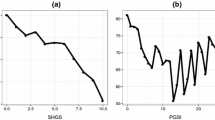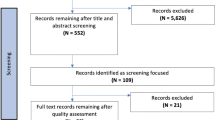Abstract
This paper examines the significance of recent developments in research relating to gambling-related harm. Previous research, it is argued, has failed to capture gambling-harm in a way that is useful to inform public policy and regulation. This is because most standardised psychometric measures and the DSM classifications have conflated gambling behaviour and harm and mostly focused on serious harms. As a result, little has generally been known about the prevalence of harm in lower risk gambling groups. Here we summarise the findings from recent harm research, the methodologies used and their conceptual implications. It is argued that strong progress has been made in the categorization and measurement of gambling harm, but that caution must be applied when applying these measures to estimate the ‘burden of disease’ associated with gambling in the community. Particular issues discussed include: the differentiation of opportunity cost and harm; the validity of additive methods involving different severities of measured harm; using comparisons with unfamiliar disorders; and the validity of prevention paradox arguments in this area of research.
Similar content being viewed by others
Notes
As this paper is being written, the UK is seeking to undertake similar work (Wardle et al. 2018).
References
Abbott, M. W., Binde, P., Hodgins, D., et al. (2013). Conceptual framework of harmful gambling: An international collaboration. Guelph: OPGRC.
Abbott, M. W., Williams, M. M., & Volberg, R. A. (2004). A prospective study of problem and regular non-problem gamblers living in the community. Substance Use and Misuse, 39, 855–884.
American Psychiatric Association. (2013). Diagnostic and statistical manual of mental disorders (5th ed.). Washington, DC: Author.
Ben-Tovim, D., Esterman, A., Tolchard, B., & Battersby, M. (2001). The Victorian Gambling Screen. Report prepared for the Gambling Research Panel, Melbourne, VIC.
Blaszczynski, A., Anjoul, F., Shannon, K., Keen, B., Pickering, D., & Wieczorek, M. (2015). Gambling harm minimisation report. Sydney: Responsible Gambling Fund.
Blaszczynski, A., Ladouceur, R., & Shaffer, H. (2004). A science-based framework for responsible gambling: The Reno model. Journal of Gambling Studies, 20, 301–317.
Bronfenbrenner, U. (1979). The ecology of human development: Experiments by nature and design. Cambridge, MA: Harvard University Press.
Browne, M., Langham, E., Rawat, V., Greer, N., Li, E., Rose, J., et al. (2016). Assessing gambling-related harm in Victoria: A public health perspective. Melbourne: Victorian Responsible Gambling Foundation.
Browne, M., Rawat, V., Greer, N., Langham, E., Rockloff, M., & Hanley, C. (2017). What is the harm? Applying a public health methodology to measure the impact of gambling problems and harm on quality of life. Journal of Gambling Issues, 36, 28–50.
Browne, M., & Rockloff, M. (2017). The dangers of conflating gambling-related harm with disordered gambling: Commentary on: Prevention paradox logic and problem gambling (Delfabbro & King 2017). Journal of Behavioral Addictions, 6, 317–320.
Browne, M., & Rockloff, M. (2018). Prevalence of gambling-related harm provides evidence for the prevention paradox. Journal of Behavioral Addictions. https://doi.org/10.1556/2006.7.2018.41.
Canale, N., Vieno, A., & Griffiths, M. D. (2016). The extent and distribution of gambling-related harms and the prevention paradox in a British population survey. Journal of Behavioral Addictions, 5, 204–212.
Delfabbro, P. H., & King, D. (2017). Prevention Paradox logic and problem gambling: Does low risk gambling impose a greater burden of harm than high risk gambling? Journal of Behavioral Addictions, 6, 163–167.
Ferris, J., & Wynne, H. (2001). The Canadian Problem Gambling Index: Final report. Ottawa: Canadian Centre on Substance Abuse.
Hancock, L., & Smith, G. (2017). Critiquing the Reno model I–IV international influence on regulators and governments (2004–2015): The distorted reality of “responsible gambling”. International Journal of Mental Health and Addiction, 15, 1151–1176.
Kessler, R. C., Hwang, I., LaBrie, R., Petukhova, M., Sampson, N. A., Winters, K. C., et al. (2008). DSM-IV pathological gambling in the National Comorbidity Survey replication. Psychological Medicine, 38, 1351–1360.
Korn, D., & Shaffer, H. (1999). Gambling and the health of the public: Adopting a public health perspective. Journal of Gambling Studies, 15, 289–365.
Langham, E., Thorne, H., Browne, M., Donaldson, P., Rose, J., & Rockloff, M. (2016). Understanding gambling related harm: A proposed definition, conceptual framework, and taxonomy of harms. BMC Public Health, 16, 1–23.
Lesieur, H., & Blume, S. (1987). The South Oaks Gambling Screen (the SOGS): A new instrument for the identification of problem gamblers. American Journal of Psychiatry, 144, 1184–1188.
Li, E., Browne, M., Rawat, V., Langham, E., & Rockloff, M. (2017). Breaking bad: Comparing gambling harms among gamblers and affected others. Journal of Gambling Studies, 33, 223–248.
Neal, P., Delfabbro, P. H., & O’Neil, M. (2005). Problem gambling and harm: Towards a national definition. Melbourne, VIC: Gambling Research Australia.
Productivity Commission. (1999). Australia’s gambling industries. Canberra: Productivity Commission.
Productivity Commssion. (2010). Gambling. Canberra: Productivity Commission.
Raisamo, S. U., Makela, P., Salonen, A., & Lintonen, T. (2014). The extent and distribution of gambling harm in Finland as assessed by the Problem Gambling Severity Index. European Journal of Public Health, 25, 716–722.
Rawat, V., Browne, M., Bellringer, M., Greer, N., Kolandai-Matchett, K., Rockloff, M., et al. (2018). A tale of two countries: Comparing disability weights for gambling problems in New Zealand and Australia. Quality of Life Research, 27, 2361–2371.
Rintoul, A. C., Livingstone, C., Mellor, A., & Jolley, D. (2013). Modelling vulnerability to gambling related harm: How disadvantage predicts gambling losses. Addiction Research & Theory, 21, 329–338.
Rossow, I., & Romelsjo, A. (2006). The extent of the ‘prevention paraox’ in alcohol problems as a function of population drinking patterns. Addiction, 101, 84–90.
Svetieva, E., & Walker, M. (2008). Inconsistency between concept and measurement: The Canadian Problem Gambling Index (CPGI). Journal of Gambling Issues, 22, 157–173.
Victorian Responsible Gambling Foundation. (2011). The Victorian Gambling Study: A longitudinal study of gambling and public health. Wave 3 findings. Melbourne: VRGF.
Victorian Responsible Gambling Foundation. (2012). A longitudinal study of gambling and health in Victoria 2008–2012. Melbourne: Victorian Responsible Gambling Foundation.
Volberg, R., & Williams, R. J. (2012). Best practices in the population assessment of problem gambling. Report prepared for the Ontario Problem Gambling Research Centre, Guelph.
Wardle, H., Reith, G., Best, D., McDaid, D., & Platt, S. (2018). Measuring gambling-related harms: A framework for action. London: GambleAware.
World Health Organisation (WHO). (2018). World Health Organization Charter. Geneva: WHO.
Funding
This paper was not supported by any funding. Both Professor Delfabbro and Dr. King’s gambling research is funded entirely consultancy work or grants received from government agencies. Both authors, from time to time, undertake peer reviews for funding bodies such as the Victorian Responsible Gambling Foundation, GambleAware, Alberta Research Institute and other similar bodies.
Author information
Authors and Affiliations
Corresponding author
Ethics declarations
Conflict of interest
Neither author reports any conflict of interest in the preparation of this manuscript.
Ethical Statement
This article does not contain any studies with human participants or animals performed by any of the authors.
Additional information
Publisher's Note
Springer Nature remains neutral with regard to jurisdictional claims in published maps and institutional affiliations.
Rights and permissions
About this article
Cite this article
Delfabbro, P., King, D.L. Challenges in the Conceptualisation and Measurement of Gambling-Related Harm. J Gambl Stud 35, 743–755 (2019). https://doi.org/10.1007/s10899-019-09844-1
Published:
Issue Date:
DOI: https://doi.org/10.1007/s10899-019-09844-1




